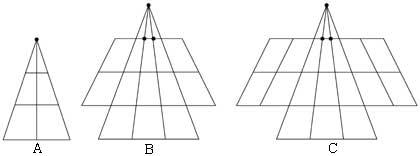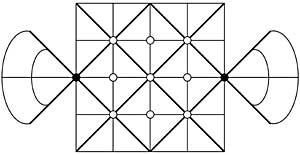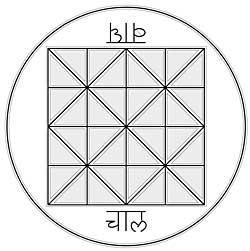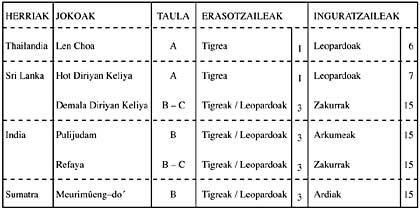Southeast Asian Games
1991/05/01 Angulo, Patxi Iturria: Elhuyar aldizkaria
From northern Europe to southern Asia, from snow to monsoon territories, from Viking and Laponian regions to tiger areas. The games in this article are distributed in India, Sri Lanka, Nepal, Thailand, Indonesia, Sumatra, Burma, Malaysia, ...
The pieces of all the games are animals and as among the animals of these regions predominates the tiger, also in these games. In addition to the tiger appear leopards, goats, dogs, sheep, humans, lambs, etc. The tables are formed by geometric figures (triangles, squares). The pieces are placed at the vertices and can only be moved above the lines. Two players participate. One player (tigers, leopards), the aggressor, eats the pieces of the other (leopards, sheep,...) of the envelope. The envelope, on the contrary, must hinder the movement of the pieces of the former, surrounding their pieces. The attacker has far fewer pieces than the envelope (see table). These are the common features of the games mentioned.

Leopard Games
This equipment needs triangular boards. Those of this group are Len Choa from Thailand, Hot Diriyan Keliya from Sri Lanka and Demala Diriyan Keliya, Pulijudam from India and Refaya and Meurimûeng-do from Sumatra
Standards:
- The initial position of the tigers is given by the black dots. The envelope will place your pieces one by one alternating with the movements of the tigers.
- All the pieces move in the same way, to a lateral vertex on a line. The envelope cannot move your pieces until they are all on the board.
- Only tigers can eat by jumping on pieces. The envelope will try to block the tigers and they try to eat as many pieces as possible to avoid blocking.
In addition to using large association tables, they are not very different from leopard games. Although they are similar to Chinese and European games using the Alkerke board, they seem to have a special origin. These games are widespread in India, Burma, Thailand, Malaysia, Indonesia and Nepal.
There are many versions, with different amounts of tiger and/or buttresses (pawns, goats, sheep, etc. ). The initial position, methods and standards vary from country to country. However, the goal of tigers is to ingest as many pieces otherwise to prevent them from ingesting.

- A player places the two tigers on the vertices of the triangles (malaysis qunq, mountains), on the black dots of the image. The other has 24 orang-orang (orang-orang = man) and in the central vertices places 9.
- All parts move to a side free vertex above the lines.
- Only tigers eat it. If at your side there is a pawn or an odd series of pawns, the tiger can jump on it or on them and take it out of the game. Eating is not necessary.
- At the beginning of the game the tiger can remove the three pawns he wants and place himself in a free vertex. In the next 15 moves, alternatively, the opposite can place his own pawns and move the tiger or eat whoever can. In this phase the pawns cannot be moved until they are all in the table.
- The tiger will lose if being surrounded cannot move or eat. If the opponent has only 10 or 11 pawns, he will have to give in, since he cannot surround the tigers.
In another version there are two tigers and 22 pawns. The tigers are located in the central vertices and the opposite places eight pawns in the next eight vertices. The match begins by eating a tiger one of his pawns. Tigers eat pawns one by one.

Bagha Chal (Nepal)
It is a very popular game. In this typical game, the Nepalese have been around for a long time. Probably this attractive game was played on the cold winter mornings. It is the national game of Nepal. It is played with tigers and goats because they are the most representative animals in Nepal. The original board and pieces were bronze.
One player has four tigers (bagha) and the other has 20 goats. The tigers' work is to attack and the most goat is to surround the tigers so that they do not move.
Standards:
- The tigers will be placed in the four corners of the picture.
- The movements of tigers and goats are carried out alternately.
- At first goats are placed on the table one by one and tigers can make a move each time. Goats cannot move until all are on the board.
- In each move you can move a tiger from one point to one side following the line, or jumping and trapping over a goat, which should be removed from the board.
- Goats do not have to leave room to jump tigers to defend themselves.
- If the tigers catch five goats, the goats lose the game. Some experts would not lose seven lost goats.
- If goats surround the tigers, that is, they leave the tigers motionless, they win the goats.
- A player cannot often bring the same goat to the same place, repeating the situation of the game. Therefore, you should move elsewhere.
(Thanks to José and Bittori).

Gai honi buruzko eduki gehiago
Elhuyarrek garatutako teknologia





